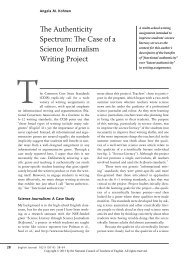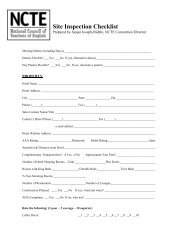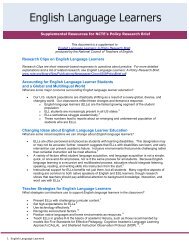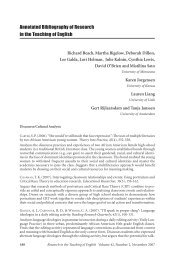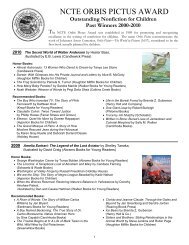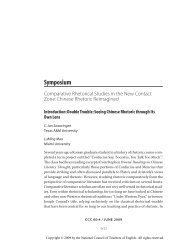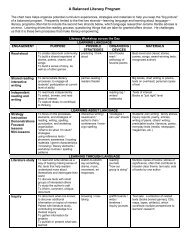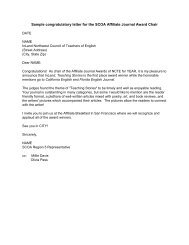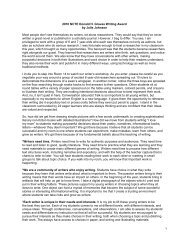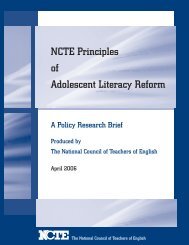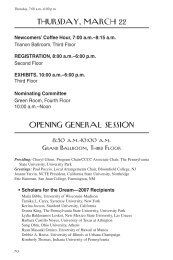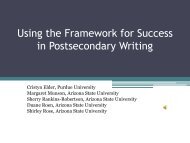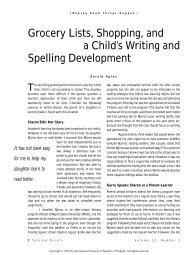<strong>Annotated</strong> <strong>Bibliography</strong> 227CASTLE, S., FOX, R. K., & SOUDER, K. O. (2006). Do pr<strong>of</strong>essional development schools (PDSs)make a difference? A comparative study <strong>of</strong> PDS and non-PDS teacher candidates. Journal <strong>of</strong>Teacher Education, 57(1), 65-80.COOK, L. S., & AMATUCCI, K. B. (2006). A high school <strong>English</strong> teacher’s develop<strong>in</strong>g multiculturalpedagogy. <strong>English</strong> Education, 38(3), 220-244.DANA, N. F., YENDOL-HOPPERY, D., & SNOW-GERONO, J. L. (2006). Deconstruct<strong>in</strong>g <strong>in</strong>quiry <strong>in</strong> <strong>the</strong>pr<strong>of</strong>essional development school: Explor<strong>in</strong>g <strong>the</strong> doma<strong>in</strong>s and contents <strong>of</strong> teachers’ questions.Action <strong>in</strong> Teacher Education, 27(4), 59-71.DANGEL, J. R. (ED.). (2006). <strong>Research</strong> on teacher <strong>in</strong>duction: Teacher education yearbook XIV.Lanham, MD: Rowman & Littlefield.DAVIS, N., THOMPSON, A., & WILLIS, J. (EDS.). (2006). Technology and teacher education: Presentrealities, future possibilities. Greenwich, CT: Information Age Publish<strong>in</strong>g.DOZIER, C. L., & RUTTEN, I. (2005/2006). Responsive teach<strong>in</strong>g toward responsive teachers: Mediat<strong>in</strong>gtransfer through <strong>in</strong>tentionality, enactment, and articulation. Journal <strong>of</strong> Literacy <strong>Research</strong>,37(4), 459-492.DUDLEY-MARLING, C., ABT-PERKINS, D., SATO, K., & SELFE, R. (2006). Teacher quality: The perspectives<strong>of</strong> NCTE members. <strong>English</strong> Education, 38(3), 167-193.EDWARDS, R., & NICOLL, K. (2006). Expertise, competence and reflection <strong>in</strong> <strong>the</strong> rhetoric <strong>of</strong> pr<strong>of</strong>essionaldevelopment. British Educational <strong>Research</strong> Journal, 32(1), 115-131.FISHER, R. (2005). Plus ça change: Change and cont<strong>in</strong>uity <strong>in</strong> literacy teach<strong>in</strong>g. Teach<strong>in</strong>g and TeacherEducation, 22(4), 424-436.HO, J. (2005). Metaphorical construction <strong>of</strong> self <strong>in</strong> teacher’s narratives. Language and Education,19(5), 359-379.JACKSON, B., LARZELERE, R., ST. CLAIR, L., CORR, M., EGERTSON, H., & FICHTER, C. (2006). The impact<strong>of</strong> HeadsUp! Read<strong>in</strong>g on early childhood educators’ literacy practices and preschool children’sliteracy skills. Early Childhood <strong>Research</strong> Quarterly, 21(2), 213-226.KINNUCAN-WELSCH, K., ROSEMARY, C. A., & GROGAN, P. R. (2006). Accountability by design <strong>in</strong>literacy pr<strong>of</strong>essional development. The Read<strong>in</strong>g Teacher, 59(5), 426-435.KOOY, M. (2006). The tell<strong>in</strong>g stories <strong>of</strong> novice teachers: Construct<strong>in</strong>g teacher knowledge <strong>in</strong> bookclubs. Teach<strong>in</strong>g and Teacher Education, 22(6), 661-674.LARSON, M. L., & PHILLIPS, D. K. (2005). Becom<strong>in</strong>g a teacher <strong>of</strong> literacy: The struggle betweenauthoritative discourses. Teach<strong>in</strong>g Education, 16(4), 311-323.LASKY, S. (2005). A sociocultural approach to understand<strong>in</strong>g teacher identity, agency and pr<strong>of</strong>essionalvulnerability <strong>in</strong> a context <strong>of</strong> secondary school reform. Teach<strong>in</strong>g and Teacher Education,21(8), 899-916.LINEK, W. M., SAMPSON, M. B., & RAINE, I. L. (2006). Development <strong>of</strong> literacy beliefs and practices:Preservice teachers with read<strong>in</strong>g specializations <strong>in</strong> a field-based program. Read<strong>in</strong>g Horizons,46(3), 183-213.LOFTY, J. S. (2006). Quiet wisdom: Teachers <strong>in</strong> <strong>the</strong> United States and England talk about standards,practice, and pr<strong>of</strong>essionalism. New York: Peter Lang.MAHER, M., & JACOB, E. (2006). Peer computer conferenc<strong>in</strong>g to support teachers’ reflection dur<strong>in</strong>gaction research. Journal <strong>of</strong> Technology and Teacher Education, 14(1), 127-151.MALOCH, B., & KINZER, C. (2006). The impact <strong>of</strong> multimedia cases on preservice teachers’ learn<strong>in</strong>gabout literacy teach<strong>in</strong>g: A follow-up study. The Teacher Educator, 41(3), 158-171.MINAYA-ROWE, L. (ED.). (2006). Effective practices <strong>in</strong> tra<strong>in</strong><strong>in</strong>g teachers <strong>of</strong> <strong>English</strong> learners. Greenwich,CT: Information Age Publish<strong>in</strong>g.OLSON, M. R., & CRAIG, C. J. (2005). Uncover<strong>in</strong>g cover stories: Tensions and entailments <strong>in</strong> <strong>the</strong>development <strong>of</strong> teacher knowledge. Curriculum Inquiry, 35(2), 161-182.SHANK, M. J. (2006). Teacher storytell<strong>in</strong>g: A means for creat<strong>in</strong>g and learn<strong>in</strong>g with<strong>in</strong> a collaborativespace. Teach<strong>in</strong>g and Teacher Education, 22(6), 711-721.
228 <strong>Research</strong> <strong>in</strong> <strong>the</strong> Teach<strong>in</strong>g <strong>of</strong> <strong>English</strong> Volume 41 November 2006SPALDING, E., & WILSON, A. H. (2006). Bowl<strong>in</strong>g toge<strong>the</strong>r: Cultivat<strong>in</strong>g communities <strong>of</strong> practice <strong>in</strong><strong>English</strong> and social studies teacher education. <strong>English</strong> Education, 38(2), 102-122.THOMPSON, C. S. (2005). Powerful pedagogy: Learn<strong>in</strong>g from and about teach<strong>in</strong>g <strong>in</strong> an elementaryliteracy course. Teach<strong>in</strong>g and Teacher Education, 22(2), 194-204.VANHULLE, S. (2005). How future teachers develop pr<strong>of</strong>essional knowledge through reflectivewrit<strong>in</strong>g <strong>in</strong> a dialogical frame. L1-Educational Studies <strong>in</strong> Language and Literature, 5(3), 287-314.WALLACE, F. H. (2006). Under pressure: Controll<strong>in</strong>g factors faced by classroom literacy teachersas <strong>the</strong>y work through a pr<strong>of</strong>essional development program. Read<strong>in</strong>g Horizons, 46(3), 143-165.WHITIN, P. (2006). Forg<strong>in</strong>g pedagogical paths to multiple ways <strong>of</strong> know<strong>in</strong>g. <strong>English</strong> Education,38(2), 123-145.Second Language LiteracyBIALYSTOK, E., & MCBRIDE-CHANG, C. (2005). Bil<strong>in</strong>gualism, language pr<strong>of</strong>iciency, and learn<strong>in</strong>g toread <strong>in</strong> two writ<strong>in</strong>g systems. Journal <strong>of</strong> Educational Psychology, 97(4), 580-590.Compares <strong>the</strong> development <strong>of</strong> phonological awareness and word decod<strong>in</strong>g <strong>in</strong> <strong>English</strong> and Ch<strong>in</strong>esefor 204 five- and six-year-olds who were monol<strong>in</strong>gual <strong>English</strong>-, bil<strong>in</strong>gual <strong>English</strong>-Ch<strong>in</strong>ese-,or Ch<strong>in</strong>ese-speak<strong>in</strong>g. F<strong>in</strong>ds that <strong>the</strong> three groups demonstrated different progress <strong>in</strong> <strong>the</strong>irearly literacy and phonological awareness acquisition. Because <strong>of</strong> differences <strong>in</strong> <strong>the</strong> two writ<strong>in</strong>gsystems and <strong>the</strong> specific strategies needed to decode words <strong>in</strong> each, bil<strong>in</strong>gualism per se did not<strong>in</strong>fluence overall decod<strong>in</strong>g results. Ra<strong>the</strong>r, children’s level <strong>of</strong> pr<strong>of</strong>iciency <strong>in</strong> each language, <strong>the</strong>irprogress <strong>in</strong> literacy development, and <strong>the</strong> relation between <strong>the</strong> two writ<strong>in</strong>g systems were most<strong>in</strong>fluential. Stresses <strong>the</strong> importance <strong>of</strong> consider<strong>in</strong>g all <strong>the</strong>se factors <strong>in</strong> research exam<strong>in</strong><strong>in</strong>g howchildren become literate <strong>in</strong> two languages.CALLAHAN, R. M. (2005). Track<strong>in</strong>g and high school <strong>English</strong> learners: Limit<strong>in</strong>g opportunity tolearn. American Educational <strong>Research</strong> Journal, 42(2), 305-328.Investigates <strong>the</strong> <strong>the</strong>oretical and practical tensions with<strong>in</strong> and among <strong>English</strong> fluency and content-areaacademics for <strong>English</strong> language learners. Subjects are representative <strong>of</strong> California’shigh school cohorts, consider<strong>in</strong>g both residency and school<strong>in</strong>g prior to immigration (n=355).F<strong>in</strong>ds that <strong>the</strong> complexity <strong>of</strong> learn<strong>in</strong>g <strong>English</strong> and academic success are also reflections <strong>of</strong> studentopportunity and teacher expectations to ga<strong>in</strong> and demonstrate competency <strong>in</strong> contentareas. Invites all stakeholders to look at academic rigor across <strong>English</strong> language models andlonger-term access to education beyond high school.CAREÉN, G. P., DRAKE, C., & CALABRESE-BARTON, A. (2005). The importance <strong>of</strong> presence: Immigrantparents’ school engagement experiences. American Educational <strong>Research</strong> Journal 42(3),465-498.Engages work<strong>in</strong>g-class immigrant parents <strong>in</strong> conversations and written narratives about <strong>the</strong>irengagement <strong>in</strong> <strong>the</strong> educational lives <strong>of</strong> <strong>the</strong>ir children. Discusses practices and structures fordialogues that describe participation <strong>in</strong>side and outside <strong>the</strong> classroom. Claims process-oriented<strong>in</strong>teractions <strong>in</strong> particular spaces, us<strong>in</strong>g specific forms <strong>of</strong> capital, creates parental engagementthat benefit children’s school experiences.DWORIN, J. E. (2006). The family stories project: Us<strong>in</strong>g funds <strong>of</strong> knowledge for writ<strong>in</strong>g. TheRead<strong>in</strong>g Teacher, 59(6), 510-520.Describes a literacy project designed to encourage students’ <strong>in</strong>-class use <strong>of</strong> both Spanish and<strong>English</strong> through collect<strong>in</strong>g and translat<strong>in</strong>g family stories. The program built on 4th grade Lat<strong>in</strong>ostudents’ funds <strong>of</strong> knowledge by focus<strong>in</strong>g on <strong>the</strong>ir languages and families as key cultural resources.Provides examples <strong>of</strong> how students collected family stories, wrote <strong>the</strong>m down and



